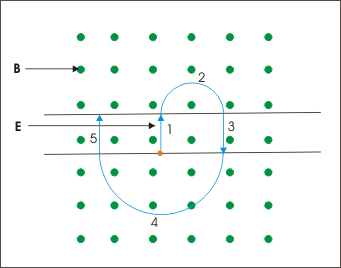The charged particle (say a positively charged proton) is released near mid point of the face of one of the Dees. Being in the electric field from one Dee to another, it is accelerated by the electric force in the direction of electric field. As the particle enters the adjoining Dee, the magnetic force, being perpendicular to it, renders the charged particle to move along a semicircular path within the Dee. By the time, it emerges again in the narrow gap separating the two Dees, the electrical polarity of Dees changes so that the particle is again accelerated again with an increase in speed.
But as the speed of the particle has increased, the radius of curvature of the semicircular path increases in accordance with the formula :
r = mv/Bq ( where B is magnetic field , m is mass , v is velocity , q is charge )
For given charge, mass and magnetic field, the radius is proportional to the speed. Clearly, the charged particle begins to move in a larger semicircular path after every passage through the gap. By the time particle reaches the gap successively, electric polarity of Dees keeps changing ensuring that the charged particle is accelerated with an increase in speed. This process continues till the charged particle reaches the periphery and exits through the guide with high energy and bombards a given target being investigated. The description of different segments of the path of accelerated particle is given here :
1: Path is a straight line. Particle is accelerated due to electric force. Speed and kinetic energy of the particle increase.
2: Path is a semicircular curve. Particle is accelerated due to magnetic force. This acceleration is centripetal acceleration without any change in speed and kinetic energy of the particle.
3: Path is a straight line. Particle is accelerated due to electric force in the direction opposite to the direction as in case 1. Speed and kinetic energy of the particle increase by same amount as in the case 1.
4: Path is a semicircular curve of greater radius of curvature due to increased speed. Particle is accelerated due to magnetic force. This acceleration is centripetal acceleration without any change in speed and kinetic energy of the particle.
5: Path is a straight line. Particle is accelerated due to electric force in the direction opposite to the direction as in case 1. Speed and kinetic energy of the particle increase by same amount as in the case 1 or 3.
We see that the particle follows consecutive larger semicircular path due to increase in the speed at the end of semicircular journey. The resulting path of charged particle, therefore, is a spiral path – not circular.

No comments:
Post a Comment